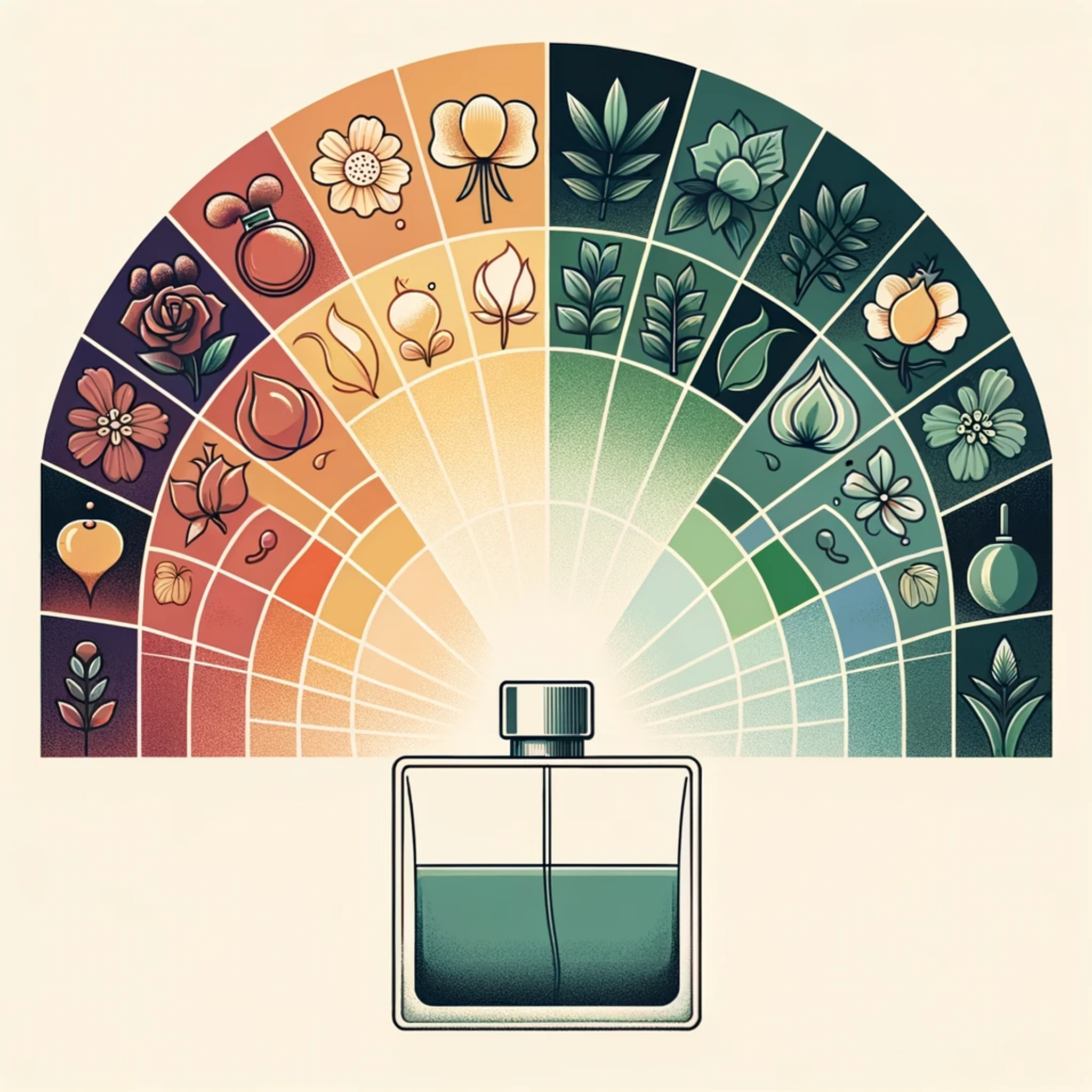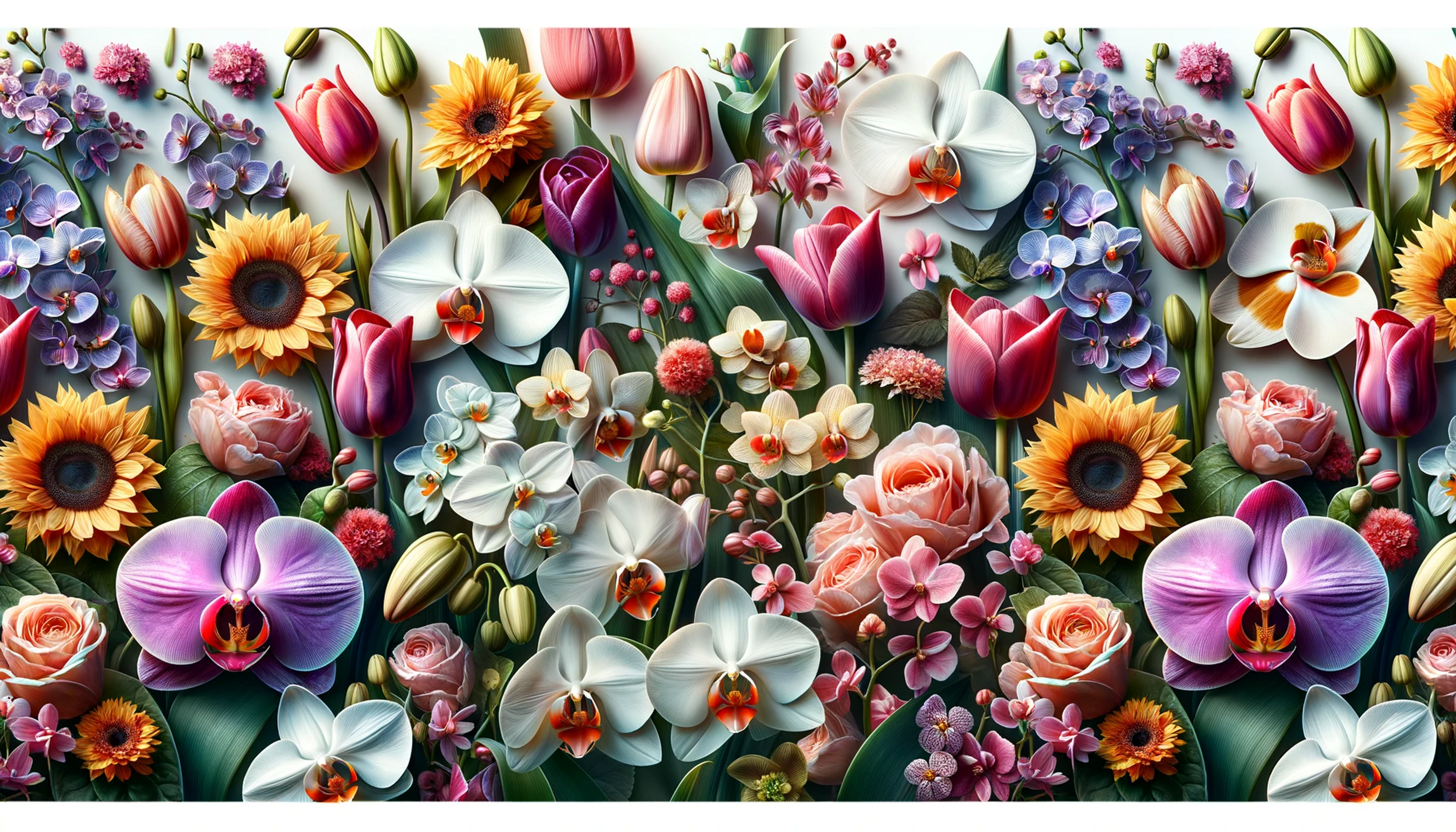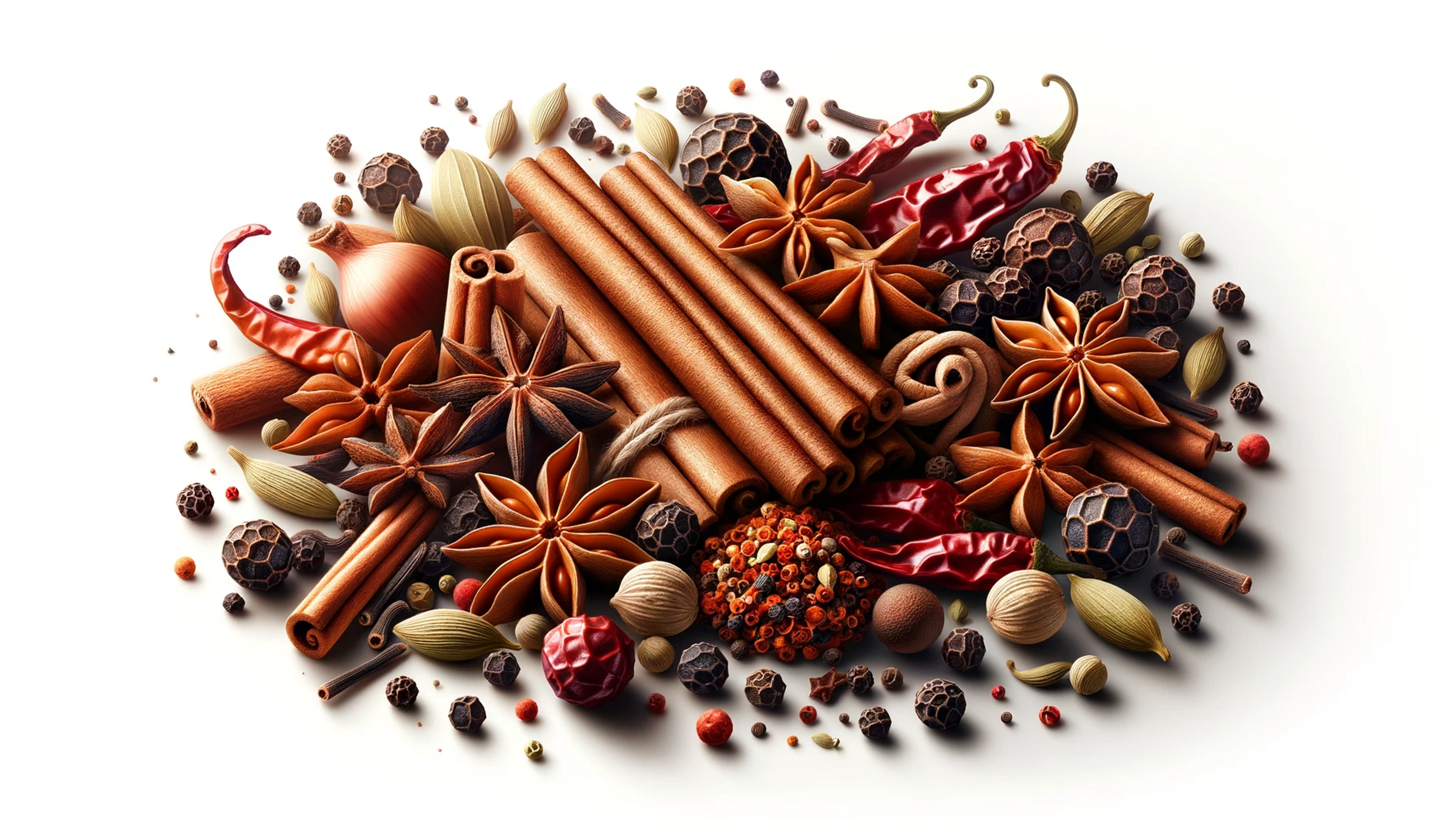
by Djordje Miladinovic
All Famous Perfume Notes and Find the Best Combination for You
Discover the most used perfume notes in perfume crafting process and what makes them so unique to get perfume essential oil for future perfumes!!
Have you ever wondered why the scent of your favorite perfume seems to evolve throughout the day?
Just like an orchestra combining different instruments to create a beautiful piece of music, Perfume Notes blends harmoniously for a lasting impression.
But what are perfume notes, which scent families do belong to, how to choose fragrance ingredients, how to extract the compounds, and how many of them exist?
Intrigued by these invisible threads weaving their magic in every fragrance bottle?
Join Chez Pierre Parfumery, your trusted fragrance guide through understanding Perfume Notes and how they shape our olfactory experiences.

What Are Perfume Notes?
Perfume Notes are the main components in perfume crafting. Extracted from the ingredients and blended to create an outstanding scent performance in the bottle, the combination of fragrance notes determines the direction of the overall perfume scent. The whole process is very complex so it is important to have knowledge of which compounds are complementary to create a unique outstanding fragrance.
There are three primary types of perfume notes: top notes, middle notes (also known as heart notes), and base notes. These fragrance notes are layered to create depth and complexity in a fragrance. When we spray a perfume, these notes unfold over time, creating a sensory experience that evolves from the first whiff to the final lingering scent.
- Top notes are the first scents that you notice when you spray a perfume. They are light, and fresh, and evaporate quickly, typically lasting up to 15 minutes. Top notes are designed to capture your attention and draw you into the fragrance. Common top notes include citrus scents like lemon, lime, and bergamot, as well as light floral scents like lavender and rose.
- Middle notes, or heart notes, are the core of the perfume. They emerge as the top notes fade, and they are typically more rounded and complex than the top notes. Middle notes often include heavier floral scents like jasmine, rose, and ylang-ylang, as well as spicy scents like cinnamon and clove. Middle fragrance notes are the essence of the perfume, and they create the main body of the fragrance. They typically last for 3 to 4 hours.
- Base notes are the final and longest-lasting scent of a perfume. They provide depth and richness to the fragrance and help anchor the lighter top and middle notes. Base notes typically include warm and rich scents like vanilla, musk, and sandalwood. These notes can last for up to 12-24 hours, lingering on the skin long after the top and middle notes have dissipated.
The combination of top, middle, and base notes creates a harmonious and balanced fragrance that evolves. The art of perfumery involves carefully selecting and blending these perfume notes to create a scent that is not only pleasing to the wearer but also reflects through the skin of each user creating a unique scent print.
Different fragrance families, such as floral, oriental, woody, and fresh, that help to categorize different scents. Each scent family has its own unique characteristics and typical ingredients, and perfumes can be a blend of various scent families to create a complex and multifaceted fragrance.
For example, a floral perfume might have top notes of lavender and rose, middle notes of jasmine and ylang-ylang, and base notes of vanilla and musk. This combination creates a feminine and romantic scent that is perfect for daytime wear.
An oriental perfume might have top notes of citrus, middle notes of cinnamon and clove, and base notes of vanilla and sandalwood. This creates a warm and exotic scent that is ideal for evening wear.
What is the Olfactory Pyramid?
The olfactory pyramid is a concept used to visually represent the different scent notes that make up a fragrance. Just as a pyramid has layers, the olfactory pyramid is divided into three main layers: top notes, middle (or heart) notes, and base notes.
Each layer corresponds to a different phase of the fragrance's lifespan on the skin, from the initial application to the final dry-down.

Olfactory Pyramid
The olfactory pyramid is a useful tool for both perfumers and consumers. For perfumers, it provides a framework for creating balanced and harmonious fragrances. By understanding how different notes interact, perfumers can craft scents that evolve smoothly from the top notes to the base notes, providing a pleasing and cohesive fragrance experience.
Perfume notes are placed in the Olfactory Pyramid to help us understand the complex structure of a fragrance and how the different scent notes interact with each other over time. By breaking down a fragrance into its components, the olfactory pyramid provides a clearer picture of its overall character and evolution.
The concept is analogous to a musical composition, where top notes are like the introductory chords, middle notes are the melody, and base notes are the lasting final notes.
Top Notes are typically light, fresh, and volatile, evaporating quickly in minutes. Examples of common top notes include citrus scents like lemon, lime, and bergamot, as well as light floral scents such as lavender and rose.
Middle Notes or heart notes emerge as the top notes begin to dissipate, and the middle or heart notes emerge. These notes are the core of the fragrance and are typically more rounded and complex than the top notes. They are responsible for the main character of the perfume and usually last from 3 to 4 hours. Common middle notes include heavier floral scents like jasmine, rose, and ylang-ylang, as well as spicy notes like cinnamon and clove.
Finally, as the middle notes fade, the base notes come to the forefront. These notes provide depth and richness to the fragrance and help anchor the lighter top and middle notes.
The olfactory pyramid is also influenced by factors like skin chemistry, temperature, and humidity, which can afect how a fragrance is perceived by different individuals.
It's like a perfume notes map that guides you to final purchasing decisions. By examining the individual notes that make up a fragrance, you can better understand what to expect from a perfume and how it will change over time.
Fragrance Scent Wheel: How to Choose Perfect Scent
The fragrance scent wheel, a concept first created by Michael Edwards in 1983, is an invaluable tool in the world of perfumery. It serves as a visual representation to help people understand the different fragrance families and how they relate to each other. The scent wheel categorizes fragrances into main families such as Floral, Oriental, Woody, and Fresh, and these are further divided into sub-families to provide a more detailed classification.

Fragrance Scent Weel by Chez Pierre
1. Floral Notes
The Floral family is often associated with romantic, light, and feminine fragrances. This family includes fragrances that are dominated by the scent of one or more flowers, such as roses, lilies, or jasmine. A classic example of a floral fragrance is Chanel No. 5, which has a prominent jasmine note. Floral fragrances can range from being light and fresh to rich and heady, depending on the flowers used and the presence of other notes.

Floral Perfume Notes
2. Oriental:
Oriental fragrances are rich, exotic, and often sensual scents that are characterized by notes such as vanilla, spices, and resins. These fragrances often have a warm and spicy profile that can be quite intense and long-lasting. A popular example of an Oriental fragrance is Opium by Yves Saint Laurent, which features notes of cinnamon, clove, and myrrh. Oriental fragrances can be further divided into sub-categories such as Spicy, Woody Oriental, and Floral Oriental.
Shop Perfume Impression Now
3. Woody:
Woody fragrances are characterized by notes such as sandalwood, cedar, and vetiver, which give them a warm, dry, and often masculine profile. These fragrances are typically rich and earthy and can range from being fresh and clean to dark and smoky. A classic example of a woody fragrance is Terre d'Hermès by Hermès, which features prominent cedar and vetiver notes. Other sub-categories within the Woody family include Mossy Woods and Dry Woods.
Shop Perfume Impression Now
4. Fresh:
Fresh fragrances are light, clean, and invigorating scents that often feature citrus, green, or aquatic notes. These fragrances are typically energizing and uplifting, making them perfect for daytime wear and warmer seasons. A popular example of a Fresh fragrance is Acqua di Gio by Giorgio Armani, which has prominent notes of bergamot, lime, and aquatic notes. Sub-categories within the Fresh family include Citrus, Green, and Water.
Shop Perfume Impression Now
Understanding the fragrance scent wheel and its families can be incredibly helpful when choosing a new perfume or cologne. It provides a useful framework to describe and categorize scents and can help you find fragrances that you will love based on your personal preferences. Whether you prefer floral, oriental, woody, or fresh scents, there is a vast world of fragrances out there waiting to be explored.
Floral Perfume Notes
- Jasmine: Native to Asia, Jasmine is a staple in perfumery, known for its sensual and intoxicating aroma. It's commonly used in oriental and floral fragrances, often blended with rose, sandalwood, and citrus notes. Fragrance notes of Jasmine are impeccable and offer complexity and sophistication in a scent, making it a favorite among perfumers.
- Rose: The quintessential floral note, roses have been used in perfumery for centuries. Their rich, sweet, and slightly spicy scent adds elegance to any fragrance. Rose is versatile and blends well with various notes, including vanilla, patchouli, and bergamot, creating a harmonious and well-rounded scent.
- Orange Blossom: Extracted from the flowers of the bitter orange tree, the orange blossom has a fresh, sweet, and slightly spicy aroma. It's often used in oriental and floral fragrances, blending well with jasmine, sandalwood, and vanilla. Orange blossom perfume notes create a vibrant and uplifting touch to any scent.
- Tuberose: A powerful and intoxicating floral note, tuberose is known for its creamy, rich, and exotic aroma. It's often used in oriental and floral fragrances, commonly paired with jasmine, rose, and ylang-ylang. Tuberose adds a lush and sensual quality to a scent, making it a popular choice for evening fragrances.
- Gardenia: With its lush, creamy, and intoxicating aroma, gardenia is a favorite among floral fragrances. It's often combined with jasmine, tuberose, and sandalwood, adding a rich and luxurious touch to a scent. Gardenia's sweet and heady aroma is perfect for creating captivating and opulent notes of perfume.
- Lily: Known for its fresh, sweet, and slightly spicy aroma, lily is a popular floral note in perfumery. It's often used in combination with rose, jasmine, and sandalwood, creating a harmonious and well-rounded scent. Lily adds a touch of elegance and sophistication to any fragrance.
- Honeysuckle: With its sweet, rich, and honey fragrance aroma, honeysuckle is a cherished floral note in perfumery. It's often blended with jasmine, rose, and sandalwood, adding depth and richness to a scent. Honeysuckle's warm and inviting aroma is perfect for creating a comforting and uplifting fragrance.
- Frangipani: Native to the tropical regions, frangipani is known for its exotic, sweet, and creamy aroma. It's often used in oriental and floral fragrances, commonly paired with jasmine, rose, and sandalwood. Frangipani adds a lush and tropical touch to any scent, making it a favorite for summer fragrances.
- Iris: Extracted from the root of the iris flower, the iris has a powdery, sweet, and slightly earthy aroma. It's often used in oriental and floral fragrances, blending well with rose, sandalwood, and vanilla. Iris adds a sophisticated and elegant touch to any scent, making it a popular choice among perfumers.
- Mandarin Orange Blossom: Crafted from the flowers of the mandarin orange tree, the mandarin orange blossom has a fresh, sweet, and slightly spicy aroma. It's often used in oriental and floral fragrances, blending well with jasmine, sandalwood, and vanilla. Mandarin orange blossom adds a vibrant and uplifting touch to any scent.
- Lavender: Known for its calming and soothing properties, lavender has a fresh, sweet, and slightly herbal aroma. It's often used in combination with rose, jasmine, and sandalwood, creating a harmonious and well-rounded scent. Lavender adds a touch of relaxation and tranquility to any fragrance.
- Lily-of-the-Valley: With its fresh, sweet, and slightly spicy aroma, lily-of-the-valley is a popular floral note in perfumery. It's often used in combination with rose, jasmine, and sandalwood, creating a harmonious and well-rounded scent. Lily-of-the-valley perfume notes provide a touch of elegance and sophistication to any fragrance.
- Peony: Known for its lush, sweet, and a bit spicy accord, peony is a favorite among floral fragrances. It's often used in combination with rose, jasmine, and sandalwood, adding depth and richness to a scent. Peony's vibrant and uplifting aroma is perfect for creating a captivating and opulent fragrance.
- Magnolia: With its creamy, sweet, and slightly spicy aroma, magnolia is a cherished floral note in perfumery. It's often mixed with jasmine, rose, and sandalwood, adding richness and luxury to a scent. Magnolia's lush and inviting aroma is perfect for creating a comforting and uplifting fragrance.
- Heliotrope: Known for its sweet, rich, and vanilla-like aroma, heliotrope is a popular floral note in perfumery. It can be compounded with jasmine, rose, and sandalwood, creating a harmonious and well-rounded scent. Heliotrope perfume note gives a touch of sweetness and warmth to any fragrance.
- Camellia: With its fresh, sweet, and slightly spicy aroma, camellia is a cherished floral note in perfumery. Most of the time, combined with jasmine, rose, and sandalwood, add depth and richness to a scent. Camellia's vibrant and uplifting aroma is perfect for creating a captivating and opulent fragrance.
- Violet: Known for its powdery, sweet, and slightly earthy aroma, violet is a popular floral note in perfumery. Usually used in combination with rose, jasmine, and sandalwood, creating a harmonious and well-rounded scent. Violet perfume note provides a touch of elegance and sophistication to any fragrance.
- Cherry Blossom: With its delicate, sweet, and slightly spicy aroma, cherry blossom is a favorite among floral fragrances. Commonly mixed with jasmine, rose, and sandalwood, it adds depth and richness to a scent. Cherry blossom's lush and inviting aroma is perfect for creating a comforting and uplifting fragrance.
- Ylang-Ylang: Known for its exotic, sweet, and slightly spicy aroma, ylang-ylang is a cherished floral note in perfumery. Blended with jasmine, rose, and sandalwood, adding a luxury feeling to the scent. Ylang-ylang's tropical fragrance aroma is perfect for creating a captivating and opulent fragrance.
- Geranium: With its fresh, sweet, and slightly herbal aroma, geranium is a popular floral note in perfumery. It's often used in combination with rose, jasmine, and sandalwood, creating a harmonious and well-rounded scent. Geranium perfume notes bring relaxation and tranquility to any fragrance combination.

Oriental Perfume Notes
- Vanilla: A universally loved note, vanilla adds a sweet, creamy, and comforting aroma to fragrances. It blends well with a range of notes, including woods, spices, and florals, creating a well-rounded and harmonious scent. Vanilla is a staple in Oriental perfumes, providing a sensual and gourmand touch.
- Cinnamon: Known for its warm, spicy, and sweet aroma, the cinnamon note is popular in the Oriental fragrance world. It gives so many layers to a scent, often blended with vanilla, amber, and wood. Cinnamon's inviting aroma evokes a sense of warmth and comfort, making it a favorite among perfumers.
- Cardamom: With its sweet, spicy, and slightly citrusy aroma, cardamom is a beloved note in Oriental perfumes. It blends well with a range of notes, including vanilla, wood, and florals, creating a harmonious and exotic scent. Cardamom adds a touch of sophistication and mystery to a fragrance.
- Nutmeg: Nutmeg introduces a rich and aromatic blend of spiciness, sweetness, and warmth, serving as a cornerstone in Oriental fragrances. It harmonizes seamlessly with vanilla, wood, and other spices, giving birth to an inviting and opulent aroma. The exotic nature of nutmeg offers an extra layer of complexity and coziness to any fragrance.
- Pepper: Known for its sharp, spicy, and hint of woody aroma, pepper is a popular note in Oriental perfumes. It adds a touch of warmth and excitement to a scent, often blended with woods, spices, and florals. Pepper's invigorating aroma creates a captivating fragrance.
- Clove: With its warm, spicy, and slightly sweet aroma, clove is a favorite note in Oriental fragrances. It pairs well with vanilla, wood, and other spices, creating a rich and inviting scent. Clove's exotic aroma provides warmth and depth to the fragrance.
- Ginger: The combination of spicy, warm, and a bit of sweet note, ginger is commonly used in Oriental perfumes. It blends well with a range of notes, including vanilla, wood, and florals, creating a harmonious and exotic scent. Ginger's invigorating aroma adds a touch of freshness and excitement to the fragrance.
- Licorice: Popular for its sweet, spicy, and slightly herbal aroma, licorice is a beloved note in Oriental fragrances. It pairs well with vanilla, wood, and other spices, creating a unique and captivating scent. Licorice adds a touch of mystery and allure to a fragrance.
- Coriander: A warm, spicy, and citrusy note, coriander is commonly used in Oriental perfumes. It blends well with a range of notes, including vanilla, wood, and florals,
creating a harmonious and exotic scent. Coriander adds a touch of sophistication and depth to a fragrance. - Cumin: Known for its warm, spicy, and slightly earthy aroma, cumin is a popular note in Oriental fragrances. It adds depth and richness to a scent, often blended with vanilla, amber, and wood. Cumin's exotic aroma evokes a sense of warmth and comfort, making it a favorite among perfumers.
- Saffron: A luxurious and exotic note, saffron adds a warm, spicy, and slightly sweet aroma to fragrances. It pairs well with vanilla, wood, and other spices, creating a rich and captivating scent. Saffron's opulent aroma adds a touch of elegance and mystery to the fragrance.
- Star Anise: With its sweet and spicy aroma, Star Anise perfume note blends well with vanilla, wood, and other spices, creating a harmonious and exotic scent. Star anise adds a touch of sophistication and allure to a fragrance.
- Coffee: A warm, rich, and slightly bitter note, coffee is commonly used in Oriental perfumes. It pairs well with vanilla, spices, or some woody perfume notes creating a unique and captivating scent. Coffee's invigorating aroma adds a touch of excitement and mystery to the fragrance.
- Tamarind: Known for its sweet, tangy, and slightly spicy aroma, tamarind is a beloved note in Oriental fragrances. It blends well with vanilla, wood, and other spices, creating a harmonious and exotic scent. Tamarind adds a touch of freshness and excitement to a fragrance.
- Allspice: A warm, spicy, and slightly sweet note, allspice is commonly used in Oriental perfumes. It pairs well with vanilla and wood creating a rich and inviting scent. Allspice's exotic aroma adds a touch of warmth and depth to the fragrance.
- Bay Leaf: The aromatic profile of bay leaf is a complex tapestry of spiciness, warmth, and a subtle herbal touch. A frequent player in Oriental perfumes, bay leaf melds harmoniously with vanilla, wood, and various spices, resulting in a well-rounded and exotic bouquet. Its addition brings a refined sophistication and layered depth to a fragrance.
- Cassia: With its aromatic dance of spiciness, warmth, and a whisper of sweetness, cassia is a cherished note in the realm of Oriental fragrances. It contributes a rich depth to a scent's composition, often finding itself intertwined with vanilla, amber, and woodsy notes. The exotic and comforting aura of cassia makes it a perennial favorite among perfumers.
- Fennel brings to the table a vibrant combination of spiciness, sweetness, and warmth, making it a sought-after note in Oriental perfumes. Its compatibility with vanilla, wood, and other spices results in a unique and captivating scent profile. The invigorating essence of fennel infuses a touch of freshness and excitement into the fragrance.
- Mace is revered for its intricate blend of spiciness, subtle woodiness, and a hint of sweetness, solidifying its status as a preferred note in Oriental fragrances. It complements vanilla, wood, and other spices beautifully, giving rise to a harmonious and exotic aroma. The sophistication and allure of mace are undeniable, adding a touch of class to any fragrance.
- Caraway: Caraway combines the warmth and spiciness of Oriental perfumes with a subtle citrusy undertone, resulting in a captivating scent profile. This note marries well with vanilla, wood, and other spices, creating a unique and layered aroma. The mysterious and deep essence of caraway adds an intriguing dimension to any fragrance.
- Pimento: With its warm, spicy essence, balanced by a touch of sweetness, pimento is a popular choice for Oriental fragrances. It brings depth and richness to a scent, often finding companionship with vanilla, amber, and woodsy notes. The exotic and comforting fragrance of pimento evokes a sense of warmth and satisfaction.
- Pink Pepper: Pink pepper is characterized by its warm, spicy essence, interwoven with a gentle sweetness, making it a fitting addition to Oriental perfume notes. It pairs excellently with vanilla, wood, and various spices, resulting in a harmonious and exotic scent. The sophistication and excitement that pink pepper lends to a fragrance are truly unmatched.
- Clove Leaf: The aromatic profile of clove leaf is a complex blend of warmth, spiciness, and a subtle sweetness, earning it a coveted spot in Oriental fragrances. Its ability to meld seamlessly with vanilla, wood, and other spices results in a unique and captivating scent. The mysterious and alluring essence of clove leaf adds an extra layer of intrigue to any fragrance.
- Anise is a distinctive perfume note that combines warmth, spiciness, and delicate sweetness, making it a go-to ingredient in Oriental perfumes. Its compatibility with vanilla, wood, and various spices creates a harmonious and exotic scent profile. The sophistication and depth that anise brings to a fragrance are truly unparalleled.
- Galanga perfume note is celebrated for its warm, spicy, and subtly sweet fragrance, making it a popular choice in the Oriental fragrance category. It adds a rich depth to a scent's composition, often blending seamlessly with vanilla, amber, and woodsy notes. The exotic and comforting essence of galanga has made it a favorite among perfumers and fragrance enthusiasts alike.
- Fenugreek: A warm, spicy, and a bit of sweet note, fenugreek is commonly used in Oriental perfume crafting. It blends well with vanilla, wood, and other spices, creating a unique and captivating scent. Fenugreek's invigorating aroma adds a touch of freshness and excitement to the fragrance.
- Curcuma (Turmeric): With its warm, spicy, and slightly bitter aroma, Curcuma (turmeric) is a favorite note in Oriental fragrances. It pairs well with vanilla, wood, and other spices, creating a harmonious and exotic scent. Curcuma adds a touch of sophistication and mystery to a fragrance.
- Dill: A warm, spicy, and slightly sweet smell, dill is commonly used in Oriental perfume scent. It blends well with vanilla, wood, and other spices, creating a unique and captivating scent. Dill adds a touch of mystery and depth to a fragrance.
- Wasabi: Known for its sharp, spicy, and slightly sweet aroma, wasabi is a popular perfume note in Oriental fragrances. It delivers exclusiveness to a scent, often blended with vanilla, amber, and wood. Wasabi's exotic aroma evokes a sense of warmth and excitement, making it a favorite among perfumers.

Woody Perfume Notes
- Sandalwood: A creamy, warm, and rich fragrance, Sandalwood is a staple in many fragrances, providing a solid base that opens deep scent character to any scent combination. The fragrance note of sandalwood is often paired with florals, spices, and citrus notes to create a harmonious and well-rounded scent. Sandalwood's soothing and sensual aroma makes it a timeless favorite among perfumers and consumers alike.
- Cedar: Known for its clean, woody, and slightly sweet smell, Cedar is a versatile note used in various fragrance compositions. It adds a touch of freshness and sophistication to a scent, often blended with florals, spices, and other woods. Cedar's invigorating aroma is both comforting and grounding, making it a popular choice in the fragrance world.
- Patchouli: A rich, earthy, and sweet perfume note, Patchouli is a beloved note in many perfumes, adding depth and character to a composition. It blends well with florals, spices, and woods, creating a harmonious and complex scent. Patchouli's exotic and sensual aroma has made it a timeless classic in the fragrance industry.
- Vetiver: With its earthy, woody, and smoky scent, Vetiver Note is a favorite among perfumers for its ability to add depth and complexity to a fragrance. It pairs well with florals, spices, and other woods, creating a well-rounded and sophisticated scent. Vetiver's grounding and calming aroma make it a popular choice for both men's and women's fragrances.
- Oakmoss: A rich, earthy, and slightly sweet fragrance note, Oakmoss is a staple in chypre and fougère fragrances, adding a touch of sophistication and depth. It mixes with florals, spices, and woods, creating a complex and harmonious scent. Oakmoss's earthy and sensual aroma has made it a favorite among perfumers for centuries.
- Agarwood (Oud): A luxurious and exotic scent, Agarwood (Oud) is known for its rich, warm, and slightly sweet aroma. It is a popular note in Oriental and Middle Eastern fragrances, adding a touch of mystery and depth. Agarwood's opulent and captivating scent makes it a favorite among perfumers and fragrance enthusiasts alike.
- Palo Santo: A warm, woody, and slightly sweet, Palo Santo fragrance note is often used in spiritual and meditative practices, as well as in perfumery. It blends well with florals, spices, and other woods, creating a harmonious and grounding scent. Palo Santo's calming aroma makes it a popular choice for fragrances and aromatherapy.
- Bamboo: Known for its clean, fresh, and woody scent, Bamboo adds a touch of lightness and sophistication to a fragrance. It pairs well with florals, citrus, and other woods, creating a well-rounded and uplifting scent. Bamboo's invigorating aroma is both refreshing and grounding, making it a popular choice in perfumery.
- Pine Tree: A crisp, clean, and a hint of sweet scent, Pine Tree is a favorite among perfumers for its ability to add a touch of freshness and vitality to a fragrance. It blends well with florals, spices, and other woods, creating a harmonious and invigorating scent. Pine Tree's uplifting aroma is both comforting and energizing, making it a popular choice for various fragrances.
- Eucalyptus: With its clean, fresh, and slightly medicinal scent, Eucalyptus is a popular note in many fragrances, adding a touch of vitality and energy. It pairs well with florals, citrus, and other woods, creating a well-rounded and invigorating scent. Eucalyptus's refreshing aroma is both soothing and energizing, making it a favorite in both perfumery and aromatherapy.
- Fig tree: A sweet, woody, and A little bit of fruity scent, Fig Tree adds a touch of elegance and sophistication to a fragrance. It blends well with florals, spices, and other woods, creating a harmonious and balanced scent. Fig Tree's inviting aroma is both comforting and luxurious, making it a popular choice among perfumers.
- Olive Tree: Known for its rich, woody, and slightly fruity smell Olive Tree is a unique and captivating note in many fragrances. It contributes complexity to a scent, often blended with florals, spices, and other woods. Olive Tree's exotic and sensual aroma makes it a favorite among perfumers and fragrance enthusiasts alike.
- Pepperwood or Hercules Club: A warm, spicy, hint of woody scent, Pepperwood adds a touch of excitement and complexity to a fragrance. It pairs well with florals, spices, and other woods, creating a harmonious and invigorating scent. Pepperwood's alluring aroma is both mysterious and captivating, making it a popular choice in the fragrance world.
- Birch: With its clean, fresh, and a bit of sweet scent, Birch is a popular note in many fragrances, adding a touch of lightness and vitality. It blends well with florals, citrus, and other woods, creating a well-rounded and invigorating scent. Birch's refreshing aroma is both uplifting and grounding, making it a favorite among perfumers.
- Almond tree: A rich, sweet, and slightly nutty scent, Almond Tree adds a touch of warmth and comfort to a fragrance. It pairs well with florals, spices, and other woods, creating a harmonious and inviting scent. Almond Tree's soothing aroma is both luxurious and comforting, making it a popular choice in perfumery.
- Cypress: Known for its clean, fresh, and slightly woody scent, Cypress is a popular note in many fragrances, adding a touch of sophistication and depth. It blends well with florals, citrus, and other woods, creating a well-rounded and invigorating scent. Cypress's uplifting aroma is both energizing and grounding, making it a favorite among perfumers.
- Mahogany: A rich, warm, and slightly sweet scent, Mahogany adds depth and character to a fragrance, often blended with florals, spices, and other woods. Its luxurious and comforting aroma makes it a popular choice among perfumers and fragrance enthusiasts alike. Mahogany's alluring scent is both sophisticated and timeless, making it a staple in many fragrances.
- Teak Wood: With its warm, woody, and slightly sweet aroma, Teak Wood is a favorite note in many fragrances, adding a touch of luxury and sophistication. It pairs well with florals, spices, and other woods, creating a harmonious and well-rounded scent. Teak Wood's inviting aroma is both comforting and luxurious, making it a popular choice in perfumery.
- Brazilian Rosewood: Rich, and warm, with a hint of sweetness, Brazilian Rosewood adds depth and character to a fragrance, often blended with florals, spices, and other woods. Its exotic and captivating aroma makes it a favorite among perfumers and fragrance enthusiasts alike. Brazilian Rosewood's luxurious scent is both sophisticated and timeless, making it a staple in many fragrances.
- Cherry Tree: Known for its sweet, fruity, and slightly woody scent, Cherry Tree adds a touch of elegance and sophistication to a fragrance. It blends well with florals, spices, and other woods, creating a harmonious and balanced scent. Cherry Tree's inviting aroma is both comforting and luxurious, making it a popular choice among perfumers.
- Apple Tree: With its fresh, fruity, and a bit of woody scent, Apple Tree is a popular note in many fragrances, adding a touch of lightness and vitality. It pairs well with florals, citrus, and other woods, creating a well-rounded and invigorating scent. Apple Tree's refreshing aroma is both uplifting and grounding, making it a favorite among perfumers.
- Maple: A sweet, warm, and a hint of woody scent, Maple adds a touch of comfort and warmth to a fragrance, often blended with florals, spices, and other woods. Its rich and inviting aroma makes it a popular choice among perfumers and fragrance enthusiasts alike. Maple's luxurious scent is both comforting and sophisticated, making it a staple in many fragrances.
- Pear Tree: Known for its sweet, fruity, and slightly woody scent, Pear Tree adds a touch of elegance and sophistication to a fragrance. It blends well with florals, spices, and other woods, creating a harmonious and balanced scent. Pear Tree's inviting aroma is both comforting and luxurious, making it a popular choice among perfumers.
- Peach Tree: With its sweet, fruity, and slightly woody scent, Peach Tree is a popular note in many fragrances, adding a touch of lightness and vitality. It pairs well with florals, citrus, and other woods, creating a well-rounded and invigorating scent. Peach Tree's refreshing aroma is both uplifting and grounding, making it a favorite among perfumers.
- Beech: A clean, fresh, and woody scent, Beech is a favorite among perfumers for its ability to add a touch of lightness and vitality to a fragrance. It blends well with florals, citrus, and other woods, creating a well-rounded and invigorating scent. Beech's uplifting aroma is both refreshing and grounding, making it a popular choice in perfumery.
- Blackwood: Known for its rich, warm, and slightly woody scent, Blackwood gives depth and character to a fragrance, often blended with florals, spices, and other woods. Its luxurious and comforting aroma makes it a popular choice among perfumers and fragrance enthusiasts alike. Blackwood's alluring scent is both sophisticated and timeless, making it a staple in many fragrances.
- Bamboo: With its clean, fresh, and slightly woody scent, Bamboo adds a touch of lightness and sophistication to a fragrance. It pairs well with florals, citrus, and other woods, creating a well-rounded and uplifting scent. Bamboo's invigorating aroma is both refreshing and grounding, making it a popular choice in perfumery.
- Oak: A rich, warm, and hint of sweet scent, Oak fragrance note contributes depth and character to a fragrance, often blended with florals, spices, and other woods. Its luxurious and comforting aroma makes it a popular choice among perfumers and fragrance enthusiasts alike. Oak's alluring scent is both sophisticated and timeless, making it a staple in many fragrances.
- Almond tree: A sweet, nutty, and slightly woody scent, Almond Tree adds a touch of warmth and comfort to a fragrance. It pairs well with florals, spices, and other woods, creating a harmonious and inviting scent. Almond Tree's soothing aroma is both luxurious and comforting, making it a popular choice in perfumery.

Fresh Perfume Notes
- Bergamot imparts a refreshing and refined aroma with a harmonious blend of fruity and mildly spicy undertones. This essential oil is meticulously extracted from the rind of the bergamot orange, a delightful hybrid of lemon and bitter orange. As a pivotal ingredient in the iconic Eau de Cologne, Bergamot lends a sophisticated touch to a multitude of fragrances, enhancing their overall character.
- Lemon: Renowned for its invigorating and vivid scent, lemon is a timeless citrus note integral to perfumery. Lemon essential oil, derived from the peel of the fruit, adds a burst of vitality and energy to fragrances, making it a versatile player in both lights, summery concoctions, and more intricate, refined blends.
- Mandarin Orange: With its delightful and invigorating fragrance, Mandarin Orange is a cherished citrus fruit in the realm of perfumery. The essential oil, derived from the fruit's peel, is a common ingredient in a variety of perfumes, bestowing a playful and captivating charm that's hard to resist.
- Lime: Celebrated for its vivacious and zest-filled scent, lime is a go-to citrus note in the world of perfumery. Lime essential oil, extracted from the fruit's peel, introduces a dynamic and energetic layer to fragrances, solidifying its status as a top choice for lively, summery perfumes.
- Orange: A quintessential citrus fragrance note, orange introduces a burst of freshness and vitality to any fragrance. This universally cherished scent is derived from the essential oil extracted from the fruit's peel and is a staple in a plethora of perfumes, especially those with a fruity and exuberant character.
- Bitter Orange offers a sharp and lively citrus scent that injects a zestful spark into any fragrance. The essential oil is extracted from the peel of the bitter orange tree and is typically blended with sweeter citrus elements, crafting a harmonious and well-rounded aromatic profile. This perfume note is frequently found in colognes and other fresh, summery fragrances.
- Blood Orange: The aroma of Blood Orange is reminiscent of a rich, freshly squeezed orange juice, balancing sweetness with a mild tanginess. Extracted from the rind of this distinctively crimson-fleshed variety, the essential oil is a crowd-pleaser in many fruity and citrusy perfumes, adding a lively and spirited touch.
- Yuzu: Native to East Asia, Yuzu offers an intriguing and aromatic scent that melds the sweetness of mandarin orange with the zestiness of grapefruit. This unique and exotic touch is derived from the essential oil extracted from the fruit's peel, making the Yuzu scent a popular choice in modern and innovative perfumes.
- Tangerine: Exuding a fragrance akin to Mandarin Orange but with an intensified sweetness, Tangerine is another cherished citrus fruit in perfumery. The essential oil, obtained from the fruit's peel, is a common note of perfume that seeks to evoke a sense of freshness and vivacity, making it a preferred choice for lively and energetic perfumes.
- Neroli: Sourced from the blossoms of the bitter orange tree, Neroli is a delicate fragrance note that combines sweet, floral, and slightly citrusy elements. This essential oil, extracted through steam distillation, is a favored ingredient in perfumery for its versatility in blending seamlessly with various other notes. Commonly found in floral, citrus, and oriental fragrances, Neroli adds a touch of freshness and sophistication.
- Petitgrain: Derived from the leaves and twigs of the bitter orange tree, Petitgrain introduces a unique fragrance that seamlessly combines fresh, woody, and slightly floral and citrusy undertones. Petitgrain perfume note adds a layer of depth and intricacy to any fragrance, making it a popular choice in fresh, woody, and oriental compositions.
- Pomelo: With a fragrance profile similar to grapefruit but less bitter, Pomelo is a large citrus fruit cherished in perfumery for its sweet and tangy scent. Pomelo perfume note is created from the fruit's peel and is frequently used to create invigorating and refreshing fragrances, adding a lively and spirited touch that's hard to resist.
- Lemon Verbena is a herb that offers a sweet, lemony aroma with a hint of floral undertones. The essential oil is extracted from the plant leaves and is often used in perfumery to create refreshing and invigorating scents. Lemon verbena adds a unique and sophisticated touch to any fragrance, making it a popular choice for fresh and lively perfumes.
- Lemon Balm is a herb that belongs to the mint family and offers a sweet, lemony aroma with a hint of mintiness. Here, perfume oil is extracted from the plant leaves and is often used in perfumery to create refreshing and invigorating scents. Lemon balm adds a unique and sophisticated touch to any fragrance, making it a popular choice for fresh and lively perfumes.
- Lemongrass is a herb that belongs to the grass family and is known for its distinct lemony aroma with a hint of earthiness. The fragrance oil is composed of plant leaves and is often used in perfumery to create refreshing and invigorating scents. Lemongrass adds a unique and exotic touch to any fragrance, making it a popular choice for modern and innovative perfumes.
- Grapefruit Peel contains grapefruit notes in a more concentrated and intense form. The essential oil is extracted from the fruit's peel and imparts a zesty aroma with a hint of sweetness. Grapefruit peel adds a vibrant and energetic touch to any fragrance, making it a popular choice for fresh and lively perfumes.
- Tangerine Zest captures essential oil extracted from the zest of the tangerine and imparts a zesty aroma with a hint of sweetness. Tangerine zest adds a vibrant and energetic touch to any fragrance, making it a popular choice for fresh and lively perfumes.
- Lemon Zest the zest of the lemon imparts a tangy aroma with a hint of sweetness. Lemon zest adds a vibrant and energetic touch to any fragrance, making it a popular choice for fresh and lively perfumes.
- Methyl Pamplemousse is a synthetic fragrance note that mimics the scent of grapefruit. This note is often used in perfumery to add a fresh and zesty aroma to the fragrance, with a hint of sweetness. Methyl Pamplemousse adds a vibrant and energetic touch to any perfume, making it a popular choice for fresh and lively scents.
- Grapefruit Leaf perfume note creates a green and herbal dimension to the tangy aroma of grapefruit. The essential oil is extracted from the leaves of the grapefruit tree and is often used in perfumery to create a refreshing and invigorating scent profile. Grapefruit leaf adds a unique and sophisticated touch to any fragrance, making it a popular choice for fresh and lively perfumes.
- Lemon Tree fragrance note combines the zesty aroma of lemon with the green and woody undertones of the leaves and wood, creating a complex and invigorating scent profile. The lemon tree is often used in fresh and lively perfumes to add depth and scent complexity to the fragrance.
- Citron is one of the oldest citrus fruits and is known for its thick rind and aromatic fragrance. The essential oil is extracted from the fruit's peel and imparts a fresh, zesty, and slightly floral scent. Citron is often used in perfumes to add a bright and invigorating citrus note, bringing a sense of vitality and freshness to the fragrance.
- Chinotto is a small, bitter citrus fruit native to Italy and is known for its intense and aromatic scent. The essential oil is extracted from the fruit's peel and is often used in traditional Italian colognes and fresh fragrances. Chinotto perfume note gives a distinctive and sophisticated citrus note to any perfume, with its complex aroma that combines sweetness, bitterness, and spiciness.
- Kaffir Lime is a citrus fruit native to Southeast Asia and is known for its distinct and aromatic scent. The fragrance oil is crafted from the fruit's peel and imparts a tangy aroma with a hint of floral and spicy undertones. Kaffir Lime fragrance accord provides a unique and exotic touch to any fragrance, making it a popular choice for modern and innovative perfumes, as well as traditional Asian-inspired scents.
- Kumquat is a small citrus fruit that offers a delightful blend of sweet and zesty scents. Kumqumat perfume oil is obtained from the fruit's peel and is often used in perfumery to create refreshing and invigorating scents. Kumquat perfume note offers a playful and charming touch to any fragrance, making it a popular choice for fruity and citrusy perfumes.
- Finger Lime is a small citrus fruit that originated from Australia. Also known as “caviar lime”, this essential oil is created from the fruit's peel and imparts a tangy aroma with a hint of sweetness. It adds an unconventional touch to any fragrance, making it a popular choice for modern and innovative perfumes.
- Calamansi, also known as calamondin, is a small citrus fruit native to the Philippines and is celebrated for its tangy and sour aroma with a hint of sweetness. Calamansi essential oil is extracted from the fruit's peel and is often used in perfumery to create refreshing and invigorating scents. Calamansi perfume note gives a unique and exotic twist to any fragrance, making it a popular choice for modern and innovative perfumes.
Citruses are a group of fruits that include orange, lemon, lime, and grapefruit, among others. The essential oils extracted from these fruits are used in perfumery to create refreshing and invigorating scents that are perfect for summer. Citruses provide a bright and zesty aroma to any fragrance, making them a popular choice for fresh and lively perfumes.

Best Summer Perfume Notes
- Citrus - Fresh, zesty, and invigorating, citrus notes like lemon, orange, and bergamot add a burst of energy perfect for hot summer days.
- Aquatic - Crisp and clean, aquatic notes bring a sense of coolness and freshness reminiscent of sea breezes and ocean waves.
- Green - Green notes like grass and leaves bring the smell of nature and gardens, evoking feelings of revitalization and liveliness.
- Fruity - Sweet and juicy, fruity notes like apple, peach, and mango add a playful and delicious twist to summer fragrances.
- Light Floral - Delicate and airy, light floral notes such as jasmine and rose add a touch of femininity and romance.
- Herbs - Fragrant and aromatic, herbal notes like mint and basil provide a refreshing and natural scent.
- Light Spices - Subtle and warming, light spices such as cardamom and coriander add an exotic touch without being overpowering.
- Marine - Reminiscent of the ocean, marine notes bring a sense of tranquility and calmness.
- White Musk - Soft and subtle, white musk adds a clean and comforting base to summer fragrances.
- Tea - Soothing and relaxing, tea notes provide a unique and refined scent that is perfect for summer relaxation.
Best Winter Perfume Notes
- Vanilla - Warm and comforting, vanilla adds a creamy and sweet base that is perfect for the colder months.
- Spices - Rich and warming, spices like cinnamon, cloves, and nutmeg add a sense of coziness and warmth to winter fragrances.
- Woods - Deep and grounding, woods such as sandalwood, cedar, and oud provide a solid and robust base for winter scents.
- Resins - Complex and rich, resins like frankincense and myrrh add a luxurious and opulent quality to winter fragrances.
- Gourmand Notes - Sweet and indulgent, gourmand notes like chocolate and coffee create a delicious and comforting scent.
- Heavy Floral - Intense and captivating, heavy floral notes like tuberose and gardenia add a sense of drama and richness.
- Amber - Warm and radiant, amber adds a golden and enveloping quality to winter scents.
- Leather - Rich and sophisticated, leather adds a sense of luxury and refinement to winter fragrances.
- Patchouli - Earthy and exotic, patchouli adds a unique and grounding element to winter scents.
- Incense - Mystical and spiritual, incense adds a smoky and enigmatic quality to winter fragrances.
Conclusion
Each note, whether it be a top, middle, or base note, plays a crucial role in the overall harmony and character of a fragrance. From the fresh and invigorating scents of citrus and herbal notes to the warm and enveloping aromas of woody and oriental notes, there is a spectrum of scents that can evoke emotions, and memories, and even transport us to different places and times.
The ability of a perfume to capture the essence of a moment, a feeling, or a memory is what makes it such a personal and intimate experience for all of us!
Frequently Asked Questions
What Perfume Note Stays on the Skin the Longest?
When you apply a perfume, the first scents you perceive are the top notes. These are generally light, fresh scents like citrus, herbs, or light fruits and tend to evaporate quickly, lasting about 15 minutes to an hour. As the top notes fade, the middle (or heart) notes become more apparent. These are the core scents of the fragrance and are typically more rounded, like florals, spices, or greens, lasting several hours. Finally, the base notes provide depth and longevity to the fragrance, with rich, heavy scents like wood, musk, or amber that can last for hours or even days. The most prominent note you smell depends on your sense of smell, the fragrance concentration, and how the scent interacts with your skin.
Which Perfume Notes Smell Expensive?
Certain notes are considered to smell expensive because they are rare, exotic, or require intricate extraction processes. Oud, derived from the agarwood tree, has a rich, complex scent that is considered luxurious. Other notes like iris, rose or jasmine are also perceived as expensive because of their sophisticated fragrances and the significant amount of raw material needed for oil production. Those rich notes associated with leather, amber, saffron, and musk, are often used in high-end and niche fragrances to create a sense of opulence.
What is a Musky Smell?
Musk has a complex scent profile that is often described as earthy, woody, and warm, with sweet, spicy, and animalic undertones. The musk scent originally came from the glandular secretions of the musk deer, which was traditionally used in the production of perfumes. Natural musk from the musk deer has a strong, animalistic, and slightly sweet scent, while synthetic musk can range from clean and powdery to rich and creamy. Musk is also known for its ability to blend well with a variety of other notes, making it a versatile ingredient in the perfumer's palette.
This animal-derived ingredient is less commonly used today, with many perfumes now opting for synthetic musk, also known as white musk, due to ethical concerns and regulations.